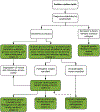2020 APHRS/HRS expert consensus statement on the investigation of decedents with sudden unexplained death and patients with sudden cardiac arrest, and of their families
- PMID: 33091602
- PMCID: PMC8194370
- DOI: 10.1016/j.hrthm.2020.10.010
2020 APHRS/HRS expert consensus statement on the investigation of decedents with sudden unexplained death and patients with sudden cardiac arrest, and of their families
Abstract
This international multidisciplinary document intends to provide clinicians with evidence-based practical patient-centered recommendations for evaluating patients and decedents with (aborted) sudden cardiac arrest and their families. The document includes a framework for the investigation of the family allowing steps to be taken, should an inherited condition be found, to minimize further events in affected relatives. Integral to the process is counseling of the patients and families, not only because of the emotionally charged subject, but because finding (or not finding) the cause of the arrest may influence management of family members. The formation of multidisciplinary teams is essential to provide a complete service to the patients and their families, and the varied expertise of the writing committee was formulated to reflect this need. The document sections were divided up and drafted by the writing committee members according to their expertise. The recommendations represent the consensus opinion of the entire writing committee, graded by Class of Recommendation and Level of Evidence. The recommendations were opened for public comment and reviewed by the relevant scientific and clinical document committees of the Asia Pacific Heart Rhythm Society (APHRS) and the Heart Rhythm Society (HRS); the document underwent external review and endorsement by the partner and collaborating societies. While the recommendations are for optimal care, it is recognized that not all resources will be available to all clinicians. Nevertheless, this document articulates the evaluation that the clinician should aspire to provide for patients with sudden cardiac arrest, decedents with sudden unexplained death, and their families.
Keywords: Brugada syndrome; Cardiac arrest; Cardiac genetics; Catecholaminergic polymorphic ventricular tachycardia; Defibrillator; Expert consensus statement; Genetic counseling; Guidelines; Long QT syndrome; Postmortem; Resuscitation; Sudden arrhythmic death syndrome; Sudden cardiac death; Sudden unexplained death; Ventricular arrhythmia.
Copyright © 2020. Published by Elsevier Inc.
Figures

















References
-
- Halperin JL, Levine GN, Al-Khatib SM, et al. Further evolution of the ACC/AHA clinical practice guideline recommendation classification system: a report of the American College of Cardiology/American Heart Association Task Force on Clinical Practice Guidelines. J Am Coll Cardiol 2016;67:1572–1574. - PubMed
-
- Towbin JA, McKenna WJ, Abrams DJ, et al. 2019 HRS expert consensus statement on evaluation, risk stratification, and management of arrhythmogenic cardiomyopathy. Heart Rhythm 2019;16:e301–e372. - PubMed
-
- Brignole M, Moya A, de Lange FJ, et al. 2018 ESC guidelines for the diagnosis and management of syncope. Eur Heart J 2018;39:1883–1948. - PubMed
Publication types
MeSH terms
Grants and funding
LinkOut - more resources
Full Text Sources
Other Literature Sources
Medical

